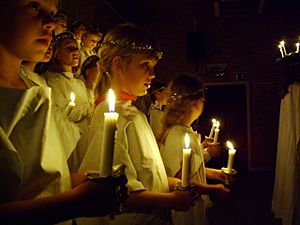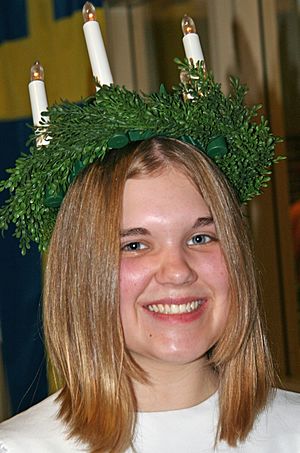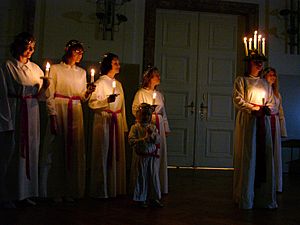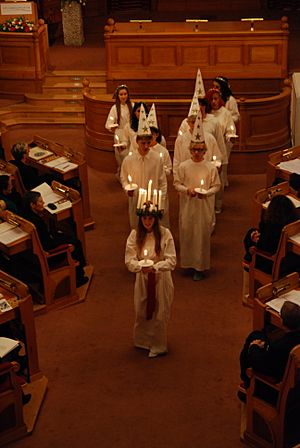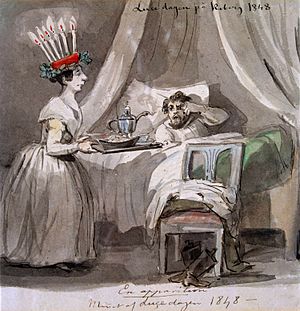St. Lucia Day facts for kids
Quick facts for kids Saint Lucy's Day |
|
|---|---|
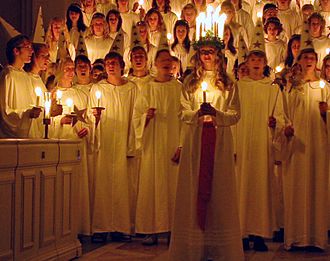
Celebration of Saint Lucy's Day in a Church of Sweden congregation in December 2006.
|
|
| Observed by | Lutherans, Roman Catholics and Anglicans, among others |
| Liturgical color | Red |
| Type | Christian |
| Date | 13 December |
| Frequency | Annual |
Saint Lucy's Day, also known as St. Lucia Day, is a special holiday celebrated on December 13 each year. It is popular in several European countries, including Sweden, Denmark, Norway, and Finland. This day honors Saint Lucy, a Christian saint.
On Saint Lucy's Day, young girls often dress up like Saint Lucy. The oldest daughter in a family might wear a white robe and a crown decorated with candles. People enjoy parades and pageants, and the girl playing Lucy often serves special cakes. Everyone sings traditional songs for the occasion. Here is one of the songs:
The night treads heavily
around yards and dwellings
In places unreached by sun,
the shadows brood
Into our dark house she comes,
bearing lighted candles,
Saint Lucia, Saint Lucia.
The celebrations also include tasty treats like ginger snaps and sweet, saffron-flavored buns. These buns are called lussekatter and are shaped like curled-up cats with raisin eyes. People usually eat them with a warm drink called glögg or coffee.
Contents
Who Was Saint Lucy?

Saint Lucy was born around the year 283 to a rich family. Her father passed away when she was five, leaving her and her mother alone. Lucy was a very religious Christian and had promised to remain unmarried. Her name, Lucia, means "light."
The story says that Lucy lived in Siracusa, Sicily, and died around the year 310. Her mother became very ill, and Lucy went to a holy place to pray for her. There, another saint appeared to Lucy in a dream. This saint told Lucy that her mother would get better through faith. Lucy then convinced her mother to cancel her planned wedding and give her wedding money to the poor.
Lucy's fiancé became very angry and told the governor that Lucy was a Christian. At that time, Christians were sometimes punished. Lucy was told to give up her Christian beliefs, but she refused. The legend says they tried to burn her, but she kept speaking, saying that her death would help other Christians. She died as a martyr, which means she died for her faith.
One story tells that Saint Lucy helped Christians who were hiding in underground tunnels called catacombs. To carry as many supplies as possible, she needed her hands free. So, she put candles on a wreath on her head to light her way.
In art, Saint Lucy is often shown holding a palm branch. This is a symbol of martyrdom.
The Lussi Night
In old Swedish traditions, the night of December 13 was known as Lussinatta, or Lussi Night. People believed that Lussi, a female spirit with some scary traits, would ride through the air with her followers. This idea might come from an older myth called the Wild Hunt.
Between Lussi Night and Yule (an old winter festival), people thought that trolls and evil spirits were very active outside. It was considered dangerous to be out during Lussi Night. Children who had been naughty were told to be extra careful, as Lussi might come down the chimney and take them away. Also, certain tasks for Yule had to be finished, or Lussi would punish the household.
The tradition of Lussevaka meant staying awake through Lussi Night to protect oneself and the home from evil. Today, this has changed into people having parties that last until morning. While there's not much proof that the Lussi legend came from northern Europe, the similar names ("Lussi" and "Lucia") and the date (December 13) suggest that these two separate traditions might have blended together in modern Scandinavian celebrations.
Why December 13?
In Scandinavia, until the mid-1700s, December 13 was thought to be the longest night of the year. This was because of the Julian Calendar used at that time, which meant December 13 was the Winter Solstice. The English poet John Donne even wrote a poem about this, called "A Nocturnal upon S. Lucy's Day, Being the Shortest Day."
Today, with the Gregorian calendar, the Winter Solstice is around December 21. However, Saint Lucy's Day stayed on December 13. This date for Saint Lucy's Day is very old, going back to the 500s and 600s AD. So, even though the calendar changed, the date for Saint Lucy's Day did not move.
In the Roman Empire, December 25 (in the Julian Calendar) was celebrated as the birthday of the Sun god, Sol Invictus. Early Christians thought this might be a good day for Jesus's birth. They believed the world was created on Spring Equinox (March 25), and that Jesus was conceived then, being born nine months later on the Winter Solstice.
Some Swedish sources say that December 13 was also called "Little Yule" and was a very important day. It marked the start of the Christmas month. When Sweden switched to the Gregorian calendar in 1753, the date lost its meaning as the shortest day, but the celebration remained.
How Saint Lucy's Day is Celebrated
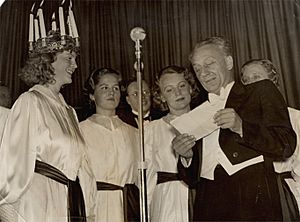
Italy
In Italy, Catholic celebrations for Saint Lucy take place on December 13. Saint Lucy's name comes from the Latin word "lux," meaning light. This connects her to light and to the days getting longer after the Winter Solstice.
Saint Lucy is the patron saint of Siracusa, Sicily. On December 13, a silver statue of Saint Lucy, which holds some of her relics, is carried through the streets. It then returns to the Cathedral of Syracuse. People in Sicily remember a story that a famine ended on her feast day when ships full of grain arrived in the harbor. Because of this, it's traditional to eat whole grains instead of bread on December 13. A common dish is cuccìa, which is boiled wheat berries often mixed with ricotta cheese and honey. It can also be a savory soup with beans.
Saint Lucy is also popular with children in some parts of North-Eastern Italy. She is said to bring gifts to good children and coal to naughty ones on the night of December 12-13. The tradition says she arrives with a donkey and her helper, Castaldo. Children leave coffee for Lucy, a carrot for the donkey, and wine for Castaldo. They must not watch her deliver the gifts, or she might throw ashes in their eyes, making them temporarily blind.
Croatia and Hungary
In Croatia, Hungary, and nearby countries, a popular tradition on Saint Lucy's Day is planting wheat grains. Today, this symbolizes the new life born in Bethlehem. Sometimes, a candle is placed in the middle of the growing plant, representing the Light of Christ that Saint Lucy brings. Wheat grains are planted in a round dish of soil and watered. If kept moist, the seeds sprout and are usually several inches high by Christmas. These green shoots, reminding people of new life, can be tied with a ribbon and placed near the Christmas tree. The older reason for planting wheat at this time was to predict how good the next year's harvest would be.
In Hungary, there's a tradition called Luca széke (Lucy's chair). People start building a stool or chair on Saint Lucy's Day, adding one piece each day until Christmas Eve. On that night, if you stand on the finished stool, you are supposed to be able to see who is a witch.
Malta
Santa Luċija is the patron saint of the villages of Mtarfa and Santa Luċija, Gozo in Malta. December 13 is also Republic Day in Malta.
In the Nordic Countries
In Sweden, Denmark, Norway, and Finland, Lucy (called Lucia) is honored on December 13 with a special ceremony. A girl is chosen to represent Lucia. She wears a white gown with a red sash and a crown of candles on her head. She leads a procession of other girls, each holding a candle. The candles symbolize the fire that could not harm Saint Lucy when she was sentenced to be burned. The girls sing a Lucia song, often to the tune of the traditional Neapolitan song Santa Lucia. The Scandinavian lyrics describe how Lucia's light overcomes the darkness. After this song, the procession sings Christmas carols or more songs about Lucia.
Sweden

The Swedish words for the Santa Lucia song are usually Natten går tunga fjät (The Night steps heavily) or Sankta Lucia, ljusklara hägring (Saint Lucy, bright mirage). There's also a simpler version for children: Ute är mörkt och kallt (Outside, it's dark and cold).
Even though Saint Lucy's Day is not an official holiday in Sweden, it is very popular. Many universities hold big dinner parties, as it's the last chance for students to celebrate before going home for Christmas.
The modern tradition of public processions in Swedish cities began in 1927. A newspaper in Stockholm chose an official Lucy for the city that year. Other local newspapers then followed this idea. Today, most Swedish cities choose a Lucy every year. Schools elect a Lucy and her helpers from among their students. A national Lucy is chosen on television from regional winners. These regional Lucies visit shopping malls, homes for older people, and churches, singing and giving out gingernut cookies (pepparkakor). The Lucy procession at the Ericsson Globe in Stockholm is noted by Guinness World Records as the largest in the world, with 1200 participants.
Boys also take part in the procession, playing different Christmas roles. Some might wear white robes with cone-shaped hats decorated with golden stars. These are called stjärngossar (star boys). Others might dress as "tomtenissar" (Santa's elves), carrying lanterns. Some even dress as gingerbread men. They sing along and also have their own songs, like Staffan Stalledräng, which tells the story of Saint Stephen, the first Christian martyr, caring for his horses.
Some people believe the Lucy celebrations in Sweden were reborn from a German Protestant tradition. In this tradition, girls dressed as angelic Christ children gave out Christmas presents. The Swedish version of this white-dressed Kindchen Jesus was called Kinken Jes. It appeared in wealthy families in the 1700s on Christmas Eve, wearing a candle-wreath and giving out candy and cakes. Another idea is that the Lucy celebration grew from old Swedish traditions of "star boys" and white-dressed angels singing Christmas carols during Advent and Christmas. Either way, the current tradition of a white-dressed woman with candles in her hair appearing on Lucy Day morning started around the Vänern area in the late 1700s and slowly spread across Sweden in the 1800s.
A special baked bun, Lussekatt (St. Lucy Bun), made with saffron, is a very popular Christmas tradition. People start eating them as early as November.
Finland
Finnish celebrations of Saint Lucy have strong ties to Swedish culture and the Swedish-speaking Finns. They celebrate "Luciadagen" a week before the Winter Solstice. Saint Lucy is seen as a "beacon of brightness" during the darkest time of the year. The first records of Saint Lucy celebrations in Finland are from 1898. Large celebrations became popular in the 1930s, a few years after they became popular in Sweden. The Saint Lucy of Finland has been chosen since 1949 and is crowned in the Helsinki Cathedral. Local Saint Lucies are chosen in most places where there are Swedish-speaking people in Finland. Recently, Finnish-speaking people have also started to enjoy these celebrations.
Denmark
In Denmark, Lucy's Day (Luciadag) was first celebrated on December 13, 1944. The tradition came directly from Sweden. It was started to "bring light in a time of darkness," and was a quiet protest against German occupation during World War II. It has been a tradition ever since.
While the tradition came from Sweden, it's a bit different in Denmark. Church celebrations are very focused on Christianity and are a yearly local event in most churches around Christmas. Schools and kindergartens also celebrate it as a special day for children before the Christmas holidays.
There are also some older traditions that are not widely followed anymore. The night before, candles are lit, and all electric lights are turned off. On the Sunday closest to December 13, Danes traditionally go to church.
The traditional Danish version of the Neapolitan song is not very Christian. The only Christian part is "Sankta Lucia." An excerpt says: "Nu bæres lyset frem | stolt på din krone. | Rundt om i hus og hjem | sangen skal tone." ("The light's carried forward | proudly on your crown. | Around in house and home | The song shall sound now.")
The Christian version used in churches is "Sankta Lucia" from 1982, written by priest Holger Lissner.
Saint Lucy's Day is also celebrated in the Faroe Islands.
Norway

Historically, Norwegians called December 13 Lussinatten, believing it was the longest night of the year. No work was allowed. From that night until Christmas, people thought spirits, gnomes, and trolls roamed the earth. Lussi, a feared enchantress, would punish anyone who dared to work. Legend also says that farm animals talked to each other on Lussinatten and were given extra food. The Lussinatt was mostly forgotten in Norway by the early 1900s, though it was still remembered as a scary night and celebrated in some areas.
It was after World War II that the modern celebration of Lucia became popular in Norway. Now, it is observed all over the country again.
Like the Swedish tradition, and unlike the Danish, Lucy is mostly a non-religious event in Norway. It is celebrated in kindergartens and schools, often up to high school. However, in recent years, it has also become part of the Advent services in the Church of Norway. Boys often join the procession, dressed as magi with tall hats and star-staffs. Sometimes, songs about Saint Stephen are sung for the boys.
For the traditional celebration, school children form processions through the school hallways, carrying candles. They hand out lussekatt buns. While rarely celebrated at home, parents often take time off work to watch these school processions in the morning. If their child is chosen to be Lucia, it is considered a great honor. Later in the day, the procession usually visits local retirement homes, hospitals, and nursing homes.
The traditional Norwegian version of the Neapolitan song, like the Danish one, is not very Christian. The only Christian part is "Sankta Lucia." An excerpt says: "Svart senker natten seg / i stall og stue. / Solen har gått sin vei / skyggene truer." ("Darkly the night descends / in stable and cottage. / The sun has gone away / the shadows loom.")
Saint Lucia (Caribbean)
Saint Lucia is a small island nation in the Caribbean. It is named after its patron saint, Saint Lucy. On December 13, the island celebrates its National Day. The National Festival of Lights and Renewal is held the night before, honoring Saint Lucy of Syracuse, the saint of light. During this celebration, decorative lights (often with a Christmas theme) are lit in the capital city of Castries. Artists show off decorated lanterns for a competition, and the official events end with fireworks. In the past, a jour ouvert celebration would continue into the sunrise of December 13.
Spain
The town of Mollerussa in Spain has held a contest for paper clothing around this day since 1963. Saint Lucy is considered the patron saint of dressmakers, who show their talent by making detailed dresses out of paper.
United States
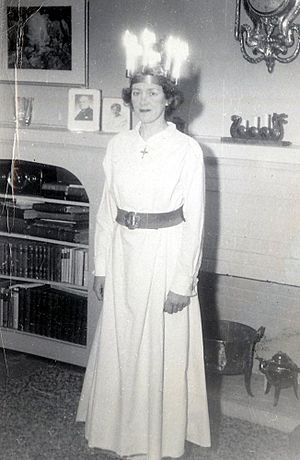

The celebration of Saint Lucy's Day is popular among Scandinavian Americans across the United States. Continuing this tradition helps people stay connected to their Scandinavian heritage.
Saint Lucy's Day is observed on December 13, with red clothes worn in church. Usually, the Sunday in Advent closest to December 13 is set aside for Saint Lucy, and the traditional Scandinavian procession is held.
The public Saint Lucy celebration in Lindsborg, Kansas, is a way to show off the town's Swedish heritage. It also brings the community together.


